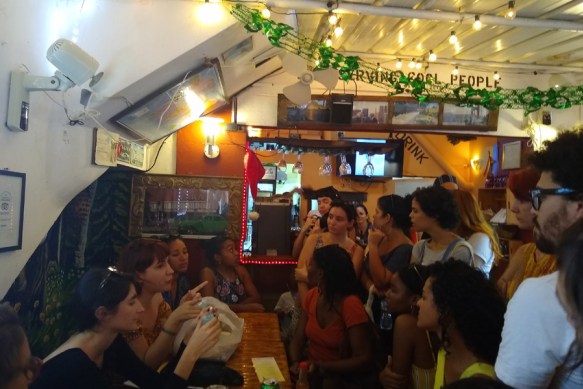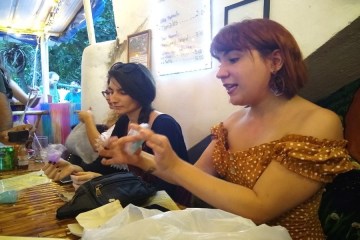Menstrual Cups: Could They Become a Trend in Cuba?

With the help of donations, young feminists are promoting the use of the menstrual cup as a healthier and more eco-friendly option, and it is being widely accepted even though it isn’t very well known in the country.
HAVANA TIMES – The campaign that 150 menstrual cups would be handed out for free was launched on social media platforms, such as Facebook and Whatsapp, just one day before the event. Even so, not every woman who attended the event walked away with a menstrual cup in hand.
Held on January 4th at the privately-run California cafe, in Havana’s Vedado neighborhood, the event was the first step in a project that seeks to facilitate access and educate women about this silicone device, which is placed inside the vagina to collect menstrual flow and is reusable for 10 years.
Add to that the fact that everything seems to indicate that they aren’t being sold on the formal market and very few of them exist on the black market, where it can cost you the equivalent of 15 dollars for a cup.
University student Samantha Olazabal (22 years old) is the main person behind the initiative with the support of a women’s group who founded La Manada, which gained immense popularity when they were the only women who repeated the feminist performance “A Rapist in your Path” on the Caribbean island, in late 2019.
“I’m surprised at just how many people came,” she told IPS at the end of the event, which involved six explanation and Q&A sessions run by the organizers, as well as handing out the donated cups.
The idea
Two years ago, Olazabal, a student at the Audiovisual Media Faculty, at the National University of Arts, received her first cup thanks to a US friend, who also supported her idea to raise funds to bring them to Cuba, for free.

“I made a video explaining what it was we wanted to do and then we launched a crowdfunding campaign on the GoFundMe platform, but it didn’t last very long because of bans against using this platform to funnel donations to Cuba,” she told us.
But, “three days later, my friend sent me a photo of a box with the first 100 cups, and then more came. Today, we have handed out over 150 and many people left empty-handed,” she said.
The interest of those who went to the event, mostly young people, was recorded so as to support the project’s continuity, which wants to branch out to every province in the country and have a website, to collect testimonies of Cuban women’s experiences with the cup.
“The idea is to start off with these menstrual cups, but our mission is to continue to educate women about menstruation, the female body, self-awareness,” Olazabal explained.
It’s imperative that young women know more about the cup and its advantages. Reasons include the fact that it reduces the risk of infection, it is the more eco-friendly option and also saves people money as they no longer have to buy sanitary towels, which are also in shortage a lot of the time, are poor quality or extremely expensive.
Reducing the environmental impact that the plastic in sanitary towels has is one of the main reasons why many people in the world are choosing this option, which has become a trend of late although rudimentary cups have been used in the world ever since 1867.
Users’ experiences
“It’s a really important reason for me and I believe that as more and more people choose this option it could hold a lot more weight,” journalist Hernandez shared, who got her first cup three years ago, which was donated too.
Many attendees said that they knew about the benefits of the cup, that they wanted to use it, but they hadn’t been able to get their hands on a menstrual cup.
“I heard about the cup two years ago, from a YouTuber, and then from a friend. I started looking for it but it’s really hard to get here. When I had the chance to travel abroad, I saw them but they cost 35-40 USD,” Yuiet Rubinos, a 20-year-old producer and designer of the KHR Khronos Art Group, said.
According to Lisandra Castro, a 28-year-old language graduate and member of La Manada, “this is a way of self-managing a need that we have and it would be good if these kinds of initiatives grew.”
“The idea is great… it’s information and a product that we wouldn’t be able to get any other way,” Claudia Karina Ricardo weighed in, a 29-year-old art historian.
Feedback from the event included a minority of women mentioned articles on the Internet about the negative effects of using the cup. The organizers urged them to always look for more information, to record and share their experiences before ruling the cup out.
“Information about how to use the cup came mostly from our own personal experiences. Of course, it’s an individual choice, not every woman adjusts to it or likes it, but the idea is to get the most women we can to know about it, as a healthier and more eco-friendly resource,” Castro said.
One of the ways the group reached out to women to get them to come to the event was a Whatsapp group created by those who took part in the “A Rapist in your Path” performance.
“There is co-living, sisterhood in this group. Samantha is also in this group, who had already worked on this project, and we came together to promote the event, to look for a colleague to make the poster, to share the little experience we have about using the cup,” the language graduate said.






Why hasn’t the “revolutionary government” of Cuba promoted the use of the menstral cup? I can think of two main reasons. One, the generals who run the country don’t have periods and could care less about such “women’s problems” and two, if the cups were widely distributed in the monopoly state retail or ration stores, then women would not have to thank the government every month or two or three when the expensive sanitary towels are sold.